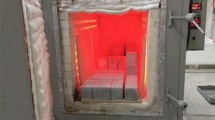Abstract
Using the detection principle of infrared thermal imaging technique and the detection principle of DRH thermal conductivity tester laboratory, we investigated the infrared thermal image inspection, coefficient of thermal conductivity, apparent density, and compressive strength test on C80 high-strength concrete(HSC) in the presence and absence of polypropylene fibers under completely heated conditions. Only slight damages were detected below 400 °C, whereas more and more severe deterioration events were expected when the temperature was above 500 °C. The results show that the elevated temperature through infrared images generally exhibits an upward trend with increasing temperature, while the coefficient of thermal conductivity and apparent density decrease gradually. Additionally, the addition of polypropylene fibers with appropriate length, diameter, and quantity contributes to the improvement of the high-temperature resistance of HSC.
Similar content being viewed by others
References
Du H X. Fire Damage Detection Technology and Eevaluation Theory and Method Reinforced Concrete Construction[D]. Shanghai: Tongji University, 2005
Hao X. Research on Microstructure and Compressive Performance of High Strength Concrete with Polypropylene Fiber Subjected to High Temperature[D]. Taiyuan: Taiyuan University of Technology, 2012
Luo S R, Li H. Study on Mechanical Properties and Cracking Behaviors of Fiber Reinforced Self-compacting Concrete [J]. Journal of Guangxi University (Natural Science Edition), 2010, 35(6): 901–907
Qualicoatknopf. Infrared Technology Principle[M]. Beijing: National Defense Industry Press, 1986
Chen B R. Infrared System[M]. Beijing: National Defence Industry Press, 1988
Zhou S Q. Infrared Radiation Measurement Basis[M]. Shanghai: Shanghai Jiaotong University Press, 1991
Yang C H. Laser and Infrared Technology Handbook[M]. Beijing: National Defense Industry Press, 1990
Zhang J X. Light and Infrared Imaging Technology[M]. Beijing: Beijing Institute of Technology Press, 1995
Wu X X. Nondestructive Testing Technology Manual[M]. Beijing: China Communications Press, 2003
Zhang X H, Ren Z P, Mei F M. Transfer Theory(second edition)[M]. Beijing: China Building Industry Press, 1985
Wang H F. Research on Mechanical ProPerties of High Strength Concrete with PolyProPylene Fiber Subjected to High Temperature[D]. Taiyuan: Taiyuan University of Technology, 2011
Huang C K. Fiber Concrete Structure[M]. Beijing: China Machine Press, 2004
Li M, Qian C X, Sun W. The Varying Rule and the Non-destructive Measuring of High Performance Concrete after Fire[J]. Industrial Construction, 2002, 32(10): 34–36
Du H X, Zhang X, Han J H. Testing and Analysis on Fired Damage of Concrete by Using Infrared Thermal Image[J]. Journal of Building Materials, 1998, 1(3): 223–226
Ju Y L, Zhang X. Investigation of Influence of PP Fiber on Performances of HPC under High Temperature[J]. Journal of Building Materials, 2004,7(1): 25–28
Zhang Y L, Zhan S L, Qian X, et al. Early Shrinkage Performance Test Study of Polypropylene Fiber Concrete[J]. New Building Materials, 2006(1): 25–28
Mehta P K, Monteiro P J M. Concrete: Microstructure Properties and Materials[M]. New York: McGraw-Hill, 2006
Lu T Q, Zhao G F, Lin Z S, et al. Microscopic Analysis of Long Standing Concrete after High Temperature[J]. Journal of Building Materials, 2003, 6(2): 135–141
Luo L L. Approximate Expression of Integrated Intensity in X-ray Diffraction Experiment[J]. College Physics, 2004, 23(12): 49–50
Author information
Authors and Affiliations
Corresponding author
Additional information
Funded by the National Natural Science Foundation of China (No. 51278325) and the Shanxi Province Natural Science Foundation (No. 2011011024-2)
Rights and permissions
About this article
Cite this article
Du, H., Wu, J., Liu, G. et al. Detection of thermophysical properties for high strength concrete after exposure to high temperature. J. Wuhan Univ. Technol.-Mat. Sci. Edit. 32, 113–120 (2017). https://doi.org/10.1007/s11595-017-1568-z
Received:
Accepted:
Published:
Issue Date:
DOI: https://doi.org/10.1007/s11595-017-1568-z




